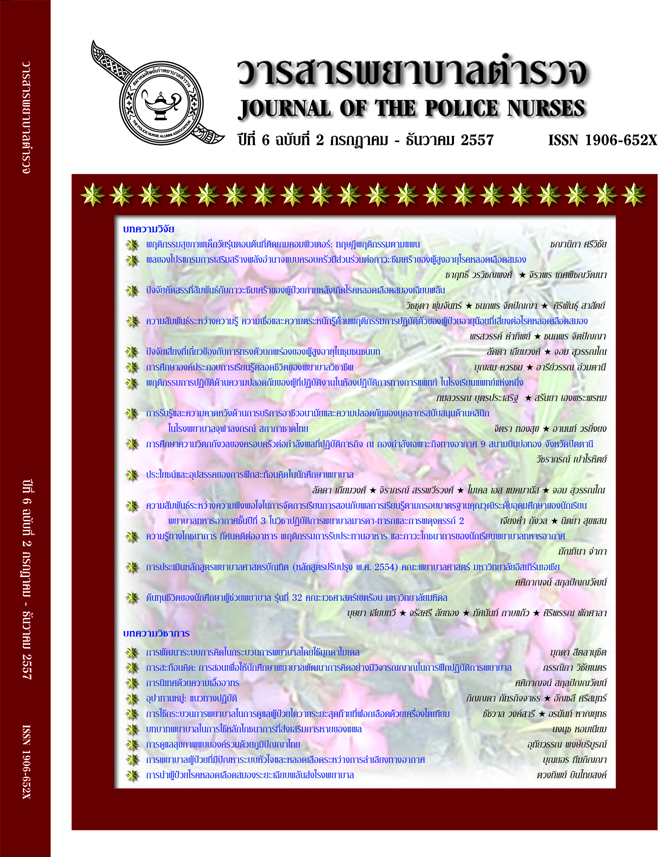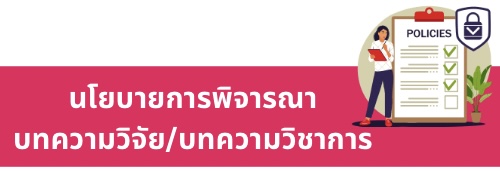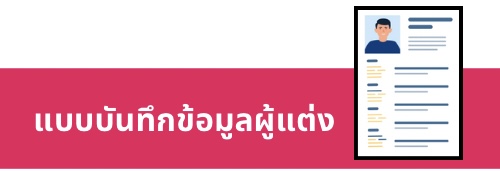ปัจจัยเสี่ยงที่เกี่ยวข้องกับการทรงตัวบกพร่องของผู้สูงอายุในชุมชนชนบท
คำสำคัญ:
การทรงตัวบกพร่อง, หกล้ม, ปัจจัยเสี่ยง, ผู้สูงอายุ, ชนบท, ไทย, Balance impairment, falls, risk factors, older adults, rural, Thaisบทคัดย่อ
บทคัดย่อ
ภาวะทรงตัวบกพร่องเป็นปัจจัยเสี่ยงที่สำคัญต่อการเกิดหกล้มและได้รับบาดเจ็บจากการหกล้ม โดยผู้สูงอายุที่มีการทรงตัวบกพร่องจะเสี่ยงต่อการเกิดหกล้ม 4 - 5 เท่า การศึกษานี้มีวัตถุประสงค์เพื่อศึกษาปัจจัยที่เกี่ยวข้องกับการทรงตัวบกพร่องของผู้สูงอายุในชุมชนชนบท จากกลุ่มตัวอย่าง จำนวน 433 คน อายุเฉลี่ย 70.36 ± 7.63 ปี และส่วนใหญ่เป็นเพศหญิง (ร้อยละ 63.7) คัดกรองการทรงตัวบกพร่องโดยทดสอบการยืนต่อเท้าเป็นแนวเส้นตรงและจับเวลา 10 วินาที พบว่า ผู้สูงอายุมีการทรงตัวบกพร่อง 104 คน (ร้อยละ24) จากการวิเคราะห์ Logistic regression ปัจจัยที่เกี่ยวข้องกับการทรงตัวบกพร่อง คือ ผู้ที่มีอายุมากขึ้น ผู้ที่มีความสามารถในการปฏิบัติกิจวัตรประจำวันลดลง มีประวัติหกล้ม มีการมองเห็นบกพร่อง เคลื่อนที่บกพร่อง มีประวัติเป็นโรคหลอดเลือดสมอง และ รับประทานยาลดความดันโลหิต ปัจจัยที่สามารถทำนายการทรงตัวบกพร่องได้แก่ ประวัติหกล้ม มีประวัติเป็นโรคหลอดเลือดสมอง การมองเห็นบกพร่อง และการเคลื่อนที่บกพร่อง ปัจจัยทั้งสี่ร่วมกันทำนายการเกิดการทรงตัวบกพร่องได้ร้อยละ 80.4
Risk Factors Related To Balance Impairment Among Rural Community-Dwelling Older Adults
Ladda Thiamwong, PhD.
Jom Suwanno, PhD.
Abstract
Balance impairment is a significant risk factor of falls and injuries among older adults. The older adults with balance impairment have more risk to fall 4-5 times. The purpose of this study was to identify risk factors of balance impairment among rural older adults. The sample (n = 433; mean age, 70.36 ± 7.63 yr) of rural community-dwelling participants was mostly female (63.7%). Balance impairment was screened by a full tandem stance testing. Exactly 24% subjects had balance impairment. Logistic regression analyses revealed that balance impairment was related to having and above advanced age, Barthel activity of daily living score, history of falls, visual impairment, mobility impairment, a history of a cerebrovascular accident (CVA) and using hypertensive drugs were significantly associated with balance impairment. Four factors including history of falls, history of CVA, visual impairment and mobility impairment could predict balance impairment for 80.4%.
Downloads
ดาวน์โหลด
เผยแพร่แล้ว
รูปแบบการอ้างอิง
ฉบับ
ประเภทบทความ
สัญญาอนุญาต
ผลงานที่ได้ตีพิมพ์แล้วจะเป็นลิขสิทธิ์ของวารสารพยาบาลตำรวจ















